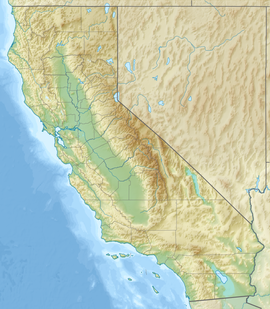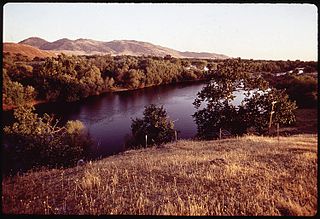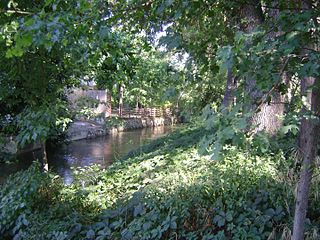| St. John's River | |
St. John's River near Visalia | |
| Country | United States |
|---|---|
| State | California |
| County | Tulare County |
| Source | Kaweah River |
| - location | Woodlake, East Visalia, California |
| - elevation | 279 ft (85 m) |
| - coordinates | 36°20′12″N119°13′23″W / 36.33667°N 119.22306°W [1] |
| Mouth | |
| - location | Traver, California |
| - elevation | 279 ft (85 m) |
| - coordinates | 36°25′05″N119°26′05″W / 36.41806°N 119.43472°W Coordinates: 36°25′05″N119°26′05″W / 36.41806°N 119.43472°W [1] |
| Length | 26.3 mi (42 km) [2] |
Map of the distributary St. Johns River also showing the Kaweah River watershed | |
The St. John's River is a distributary of the Kaweah River in the San Joaquin Valley of California in the United States. The river begins at a diversion dam at McKay's Point, about a mile west of Lemon Cove. The distributary flows west along the north side of the city of Visalia, where it joins Elbow Creek, continuing west to Cross Creek.
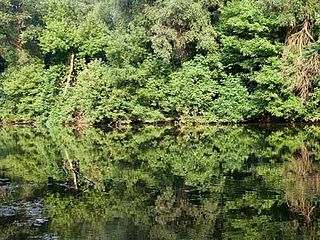
A distributary, or a distributary channel, is a stream that branches off and flows away from a main stream channel. They are a common feature of river deltas. The phenomenon is known as river bifurcation. The opposite of a distributary is a tributary. Distributaries usually occur as a stream nears a lake or an ocean, but they can occur inland as well, such as on alluvial fans or when a tributary stream bifurcates as it nears its confluence with a larger stream. In some cases, a minor distributary can divert so much water from the main channel that it can become the main route.

The Kaweah River is a river draining the southern Sierra Nevada in Tulare County, California in the United States. Fed primarily by high elevation snowmelt along the Great Western Divide, the Kaweah begins as four forks in Sequoia National Park, where the watershed is noted for its alpine scenery and its dense concentrations of giant sequoias, the largest trees on Earth. It then flows in a southwest direction to Lake Kaweah – the only major reservoir on the river – and into the San Joaquin Valley, where it diverges into multiple channels across an alluvial plain around Visalia. With its Middle Fork headwaters starting at almost 13,000 feet (4,000 m) above sea level, the river has a vertical drop of nearly two and a half miles (4.0 km) on its short run to the San Joaquin Valley, making it one of the steepest river drainages in the United States. Although the main stem of the Kaweah is only 33.6 miles (54.1 km) long, its total length including headwaters and lower branches is nearly 100 miles (160 km).

The San Joaquin Valley is the area of the Central Valley of the U.S. state of California that lies south of the Sacramento–San Joaquin River Delta and is drained by the San Joaquin River. It comprises seven counties of Northern and one of Southern California, including, in the north, all of San Joaquin and Kings counties, most of Stanislaus, Merced, and Fresno counties, and parts of Madera and Tulare counties, along with a majority of Kern County, in Southern California. Although a majority of the valley is rural, it does contain cities such as Fresno, Bakersfield, Stockton, Modesto, Turlock, Porterville, Visalia, Merced, and Hanford.
Contents
Water from this distributary historically flowed into Tulare Lake, as did water continuing down the main channel of the Kaweah. Tulare lake was the terminal sink of an endorheic basin in southern San Joaquin Valley which was also watered by the Kern, Tule, and by some distributaries of the Kings River. Presently water from these rivers is typically used up for irrigation. Water from the St. John's irrigates many thousands of acres of farmland in the Sequoia Valley.

Tulare Lake, Laguna de Tache in Spanish, is a freshwater dry lake with residual wetlands and marshes in the southern San Joaquin Valley, California, United States. After Lake Cahuilla disappeared in the 17th century, Tulare Lake was the largest freshwater lake west of the Mississippi River and the second-largest freshwater lake entirely in the United States, based upon surface area. A remnant of Pleistocene-era Lake Corcoran, Tulare Lake dried up after its tributary rivers were diverted for agricultural irrigation and municipal water uses.

An endorheic basin is a limited drainage basin that normally retains water and allows no outflow to other external bodies of water, such as rivers or oceans, but converges instead into lakes or swamps, permanent or seasonal, that equilibrate through evaporation. Such a basin may also be referred to as a closed or terminal basin or as an internal drainage system or interior drainage basin.

The Kern River, originally Rio de San Felipe, later La Porciuncula, is a river in the U.S. state of California, approximately 165 miles (270 km) long. It drains an area of the southern Sierra Nevada mountains northeast of Bakersfield. Fed by snowmelt near Mount Whitney, the river passes through scenic canyons in the mountains and is a popular destination for whitewater rafting and kayaking. It is the only major river in the Sierra Nevada mountain range that drains in a southerly direction.
At a point about 4 miles (6.4 km) north of Farmersville, the St. John's enters Elbow Creek. It flows then westerly to Cross Creek at a point north of Goshen and back into Elbow Creek at the confluence of Elbow and Cross creeks. This water in time of flood finds its way into the Tulare Lake Basin through Elbow Creek. [3]

Farmersville is a city in the San Joaquin Valley in Tulare County, California, United States, just to the east of Visalia, California. The population was 10,588 at the 2010 census, up from 8,737 at the 2000 census.
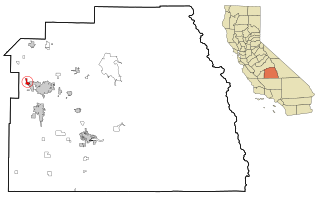
Goshen is a census-designated place (CDP) near Visalia, in Tulare County, California, United States. The population was 3,006 at the 2010 census, up from 2,394 at the 2000 census. Until the twentieth century, Goshen was an island in a marsh at the edge of Tulare Lake, formerly the largest freshwater lake west of the Great Lakes until drained.


